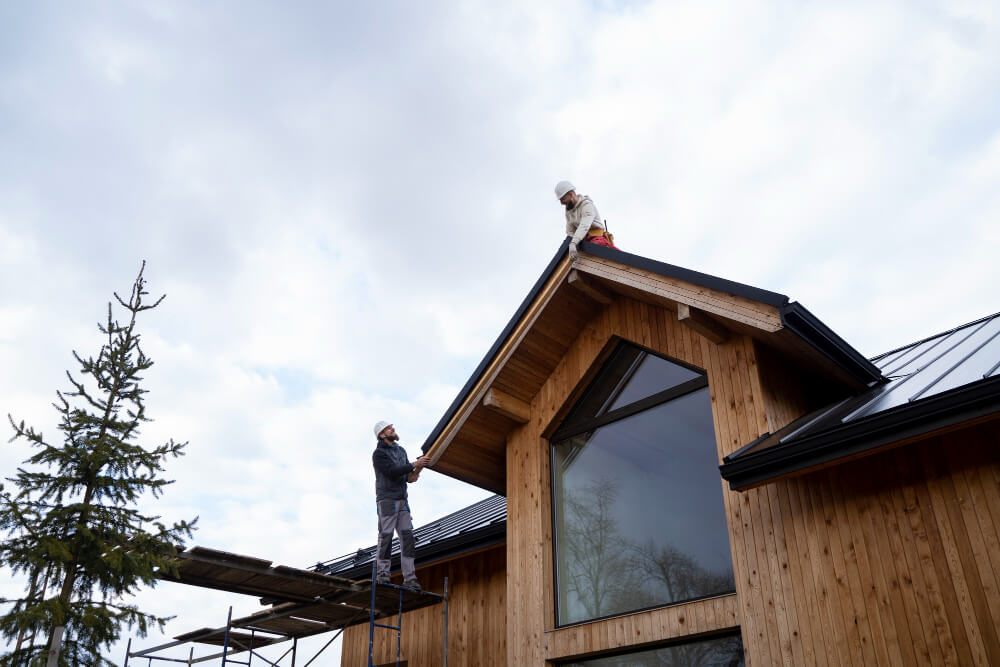Your roof won’t text you when it’s ready to give out. It just quietly breaks down until water is dripping on your couch. That’s not ideal.
Roofs are like tires—you can’t ignore the wear forever. And waiting until it fails? That’s a wallet-buster.
Let’s break down the signs it’s time to stop patching and start replacing.
1. Your Roof Has Hit Retirement Age
Most asphalt shingle roofs last about 20 to 25 years. Metal? 40 to 70 years. But if yours is pushing 20 and has seen a few rough winters, it’s likely on borrowed time.
Think of it like a pair of running shoes. They might still look okay, but you feel every rock on the path. The damage is in the guts, not always on the surface.
Bonus tip: If your neighborhood was built around the same time, and your neighbors are all getting new roofs—it’s probably not a coincidence.
2. Shingles Are Leaving Like It’s a Fire Drill
Shingles are supposed to lay flat like a well-made bed. If they’re curling, cracking, or MIA entirely, you’ve got problems.
A handful missing? Patch job. But if your yard looks like it rained roof confetti, it’s time to talk to a roofer.
One square (100 sq ft) of missing shingles can leave your home exposed to thousands in water damage. That’s not a scare tactic—it’s what insurance adjusters see after every storm.
Read Also: Why Choosing a Local Roofing Company Matters
3. Water Stains on the Ceiling = Roof’s Cry for Help
Those brown rings on your ceiling? They’re not just ugly—they’re clues.
And they don’t show up overnight. By the time water leaves a mark indoors, it’s been creeping in for a while.
Here’s a fun fact (well, not “fun” exactly): A leak that drips once a minute can result in over 30 gallons of water inside your attic every month.
That’s not just a puddle. That’s mold fuel.
4. You See Daylight in the Attic—and It’s Not Romantic
Grab a flashlight, head to your attic during the day, and kill the lights. If you see beams of sunlight through the roof boards, that’s not “character”—that’s a sign of rot, holes, or both.
Air gets in, heat escapes, and before you know it, you’re heating the neighborhood.
5. There’s a Sag in Your Step—Or Your Roofline
Your roof should be straight as a ruler. If there’s a dip, it usually means water has compromised the decking or framing.
That’s the kind of thing that goes from “eh, I’ll fix it later” to “hello, insurance claim” very quickly.
6. Moss Is Thriving. Too Bad It’s Not a Garden.
Moss on a roof may look quaint, like an English cottage. But unless you also have sheep grazing out front, it’s bad news.
Moss traps moisture. Moisture rots wood. And rotted wood doesn’t hold up shingles—or anything else, really.
The National Roofing Contractors Association warns that unchecked moss growth can cut your roof’s life expectancy in half.
7. Your Energy Bill Just Got a Personality Change
If your AC or heater is working double-time, your roof may be to blame. Damaged shingles and poor ventilation let energy slip out like money through a holey pocket.
Energy Star estimates that proper insulation and roofing materials can cut heating and cooling costs by up to 15%.
Your HVAC system shouldn’t have to fight the roof just to keep you comfortable.
8. You’ve Patched More Than You’d Like to Admit
We all try to stretch the lifespan of big-ticket items. But if your roofer knows your dog’s name and your favorite coffee, you’re probably replacing shingles too often.
Small repairs are fine. But constant ones? That’s a signal that the system is failing as a whole.
9. After a Major Storm, You Haven’t Looked Up
Hail, flying branches, or high winds can turn a solid roof into Swiss cheese. And not all damage is visible from the ground.
If your area took a beating and you haven’t had someone inspect your roof, you might be sitting on hidden damage.
Storm chasers will show up. Instead, call someone you trust before the leaks do.
Read Also: The Importance of Proper Roof Ventilation and Insulation
10. You’ve Just Got a Bad Feeling
Sometimes, you just know. Maybe you’ve been holding off. Maybe you’ve patched the same spot twice. Maybe every time it rains, you cross your fingers.
Listen to that voice. It’s usually right.
And no, you don’t have to wait for water to pour in to do something about it. Replacing a roof before a total failure can actually save money.
A Quick Note on Cost
Roof replacements aren’t cheap. The average cost in the U.S. is around $9,000, but it can range from $5,000 to $20,000 depending on materials, pitch, and square footage.
But here’s the kicker: A new roof can add around $12,000 to your home’s resale value, according to Remodeling Magazine’s Cost vs. Value report.
You’re not just spending—you’re investing.
Roof problems don’t fix themselves. And hoping it holds out another year isn’t a strategy—it’s a gamble. Check for the signs. Ask questions. And if something feels off, bring in a pro. Because peace of mind, like a solid roof, is something you shouldn’t skimp on.

